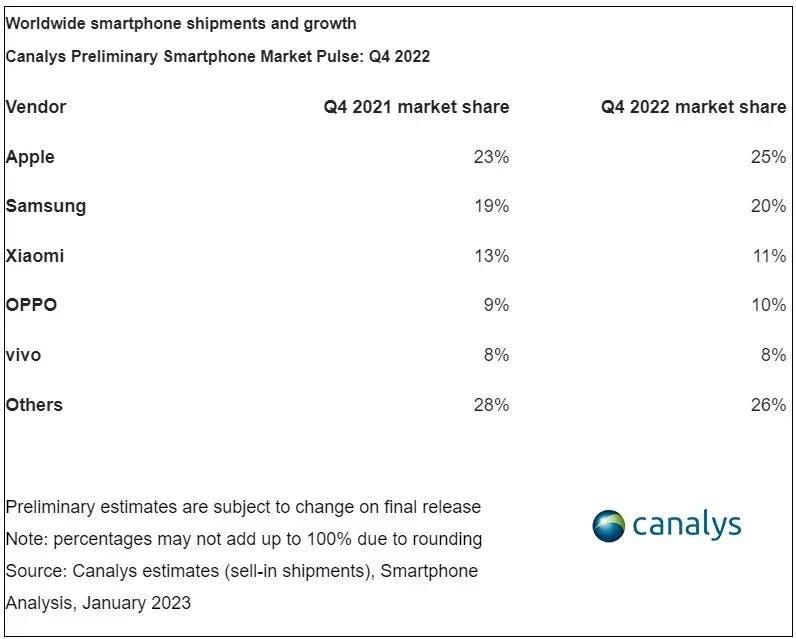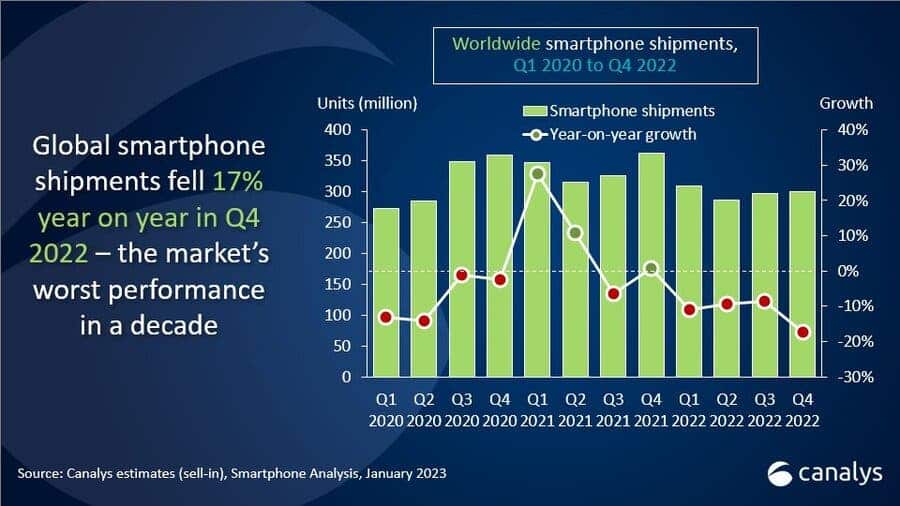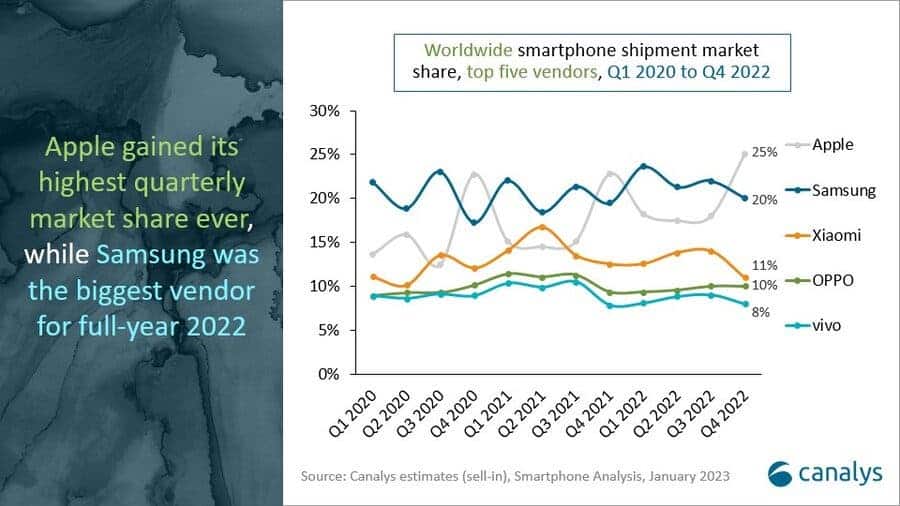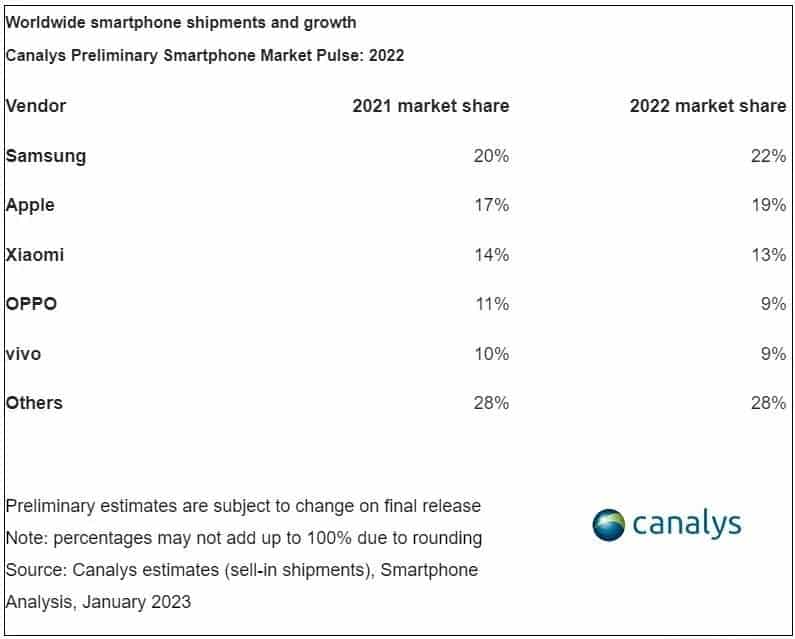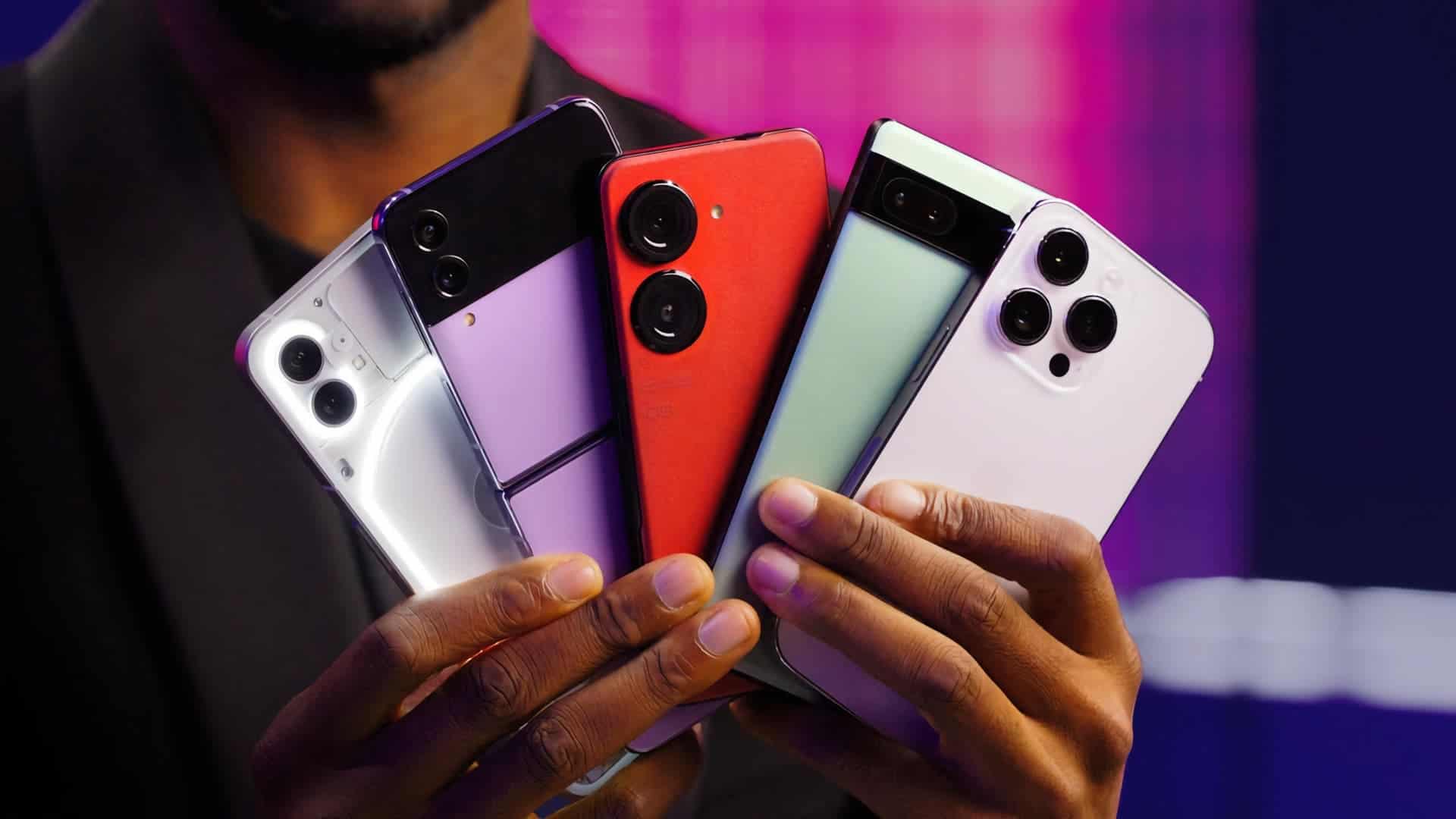Samsung and Apple are succeeding and making headway in a global market that contracted by 11% in 2022. Xiaomi, Oppo, and Vivo, their Top 5 competitors, are all lagging behind.
Which companies were able to sell the most in the smartphone market in 2022? There’s not much of a surprise. The three winners are the same as they were the previous year, according to analysis firm Canalys, which bases its findings on the number of phones supplied by factories worldwide. The top three are Samsung, Apple, and Xiaomi. Then we have Oppo and Vivo completing the top 5.
If the rankings have not changed, the numbers show that the top two consistently dominate. Samsung rises from 20 to 22% and Apple from 17 to 19%, while Xiaomi drops from 14 to 13% and Oppo and Vivo drop to 9% of global sales.
It would be easy to assume that the two giants in the front had won everything, but the situation is more complicated than that. In 2022, shipments of smartphones dropped drastically by 11% to fewer than 1.2 billion.
Apple is the unquestionable champion of the fourth quarter
Given that the iPhone release timetable has made it common knowledge that Apple often leads the fourth quarter, it should also be emphasized that Apple is having an extraordinary end to the year. With 23% of the market share in 2020 and 2021, the Apple brand ultimately took the top spot with 25% of sales this year.
In the fourth quarter, Samsung increased from 19 to 20%, continuing its upward trajectory, much like Oppo, which came in at number four and improved from 9 to 10%. Vivo continues to have 8% of sales, while Xiaomi narrowly holds onto third place with 11%.
How can such performances be explained?
The one would be inclined to immediately blame the brands’ lack of creativity for this decline, but the analytical business, for its part, blames a complex economic environment. “In a hard macroeconomic situation during 2022, smartphone vendors have had difficulty. The fourth quarter represents the poorest yearly and quarterly results in ten years “said Runar Bjrhovde, an analyst for Canalys. According to the company, 2023 will be as challenging.
“The channel is highly cautious with taking on new inventory, contributing to low shipments in Q4. Backed by strong promotional incentives from vendors and channels, the holiday sales season helped reduce inventory levels. While low-to-mid-range demand fell fast in previous quarters, high-end demand began to show weakness in Q4. The market’s performance in Q4 2022 stands in stark contrast to Q4 2021, which saw surging demand and easing supply issues.”
Who sold the most smartphones in 2022?
Gizchina News of the week
The market for smartphones as a whole is struggling. However, not everyone experiences this collapse as quickly as others. Vivo, Xiaomi, and Oppo all experience steep declines, but Samsung and Apple are maintaining their sales despite the crisis.
The smartphone market has stumbled a little in 2022, falling 11%. At least that’s what the research firm Canalys contends, as it tracks smartphone shipments from manufacturers, a reliable indicator of global sales volume.
They claim that 1.2 billion phones have been sold globally. Additionally, we can readily estimate the number of phones sold by Samsung, Apple, Xiaomi, Oppo, and Vivo as the company also reports the market shares of the top 5 over the course of the year.
“Vendors will approach 2023 cautiously, prioritizing profitability and protecting market share,” said Canalys Research Analyst Le Xuan Chiew. “Vendors are cutting costs to adapt to the new market reality. Building strong partnerships with the channel will be important for protecting market shares as difficult market conditions for both channel partners and vendors can easily lead to strenuous negotiations.”
How many smartphones were sold by the Top 5
Remember that these are estimates, especially given that Canalys makes a point of rounding up and down occasionally to display percentages. Here is the calculation’s outcome:
- Samsung: around 264 million (22%);
- Apple: around 228 million (19%);
- Xiaomi: around 156 million (13%);
- Oppo: around 108 million (9%).
- Vivo: around 108 million (9%).
Here is what it gives when compared to 2021, when, per Canalys, 1.35 billion smartphones had been sold:
- Samsung: around 274.5 million (20%);
- Apple: around 230.1 million (17%);
- Xiaomi: around 191.2 million (14%);
- Oppo: around 145.1 million (11%);
- Vivo: approximately 129.9 million (10%).
“Though inflationary pressures will gradually ease, the effects of interest rate hikes, economic slowdowns and an increasingly struggling labor market will limit the market’s potential,” added Chiew. “This will adversely affect saturated, mid-to-high-end-dominated markets, such as Western Europe and North America. While China’s re-opening will improve domestic consumer and business confidence, government stimuli are only likely to show effects in six to nine months and demand in China will remain challenging in the short term. Still, some regions are likely to grow in the second half of 2023, with Southeast Asia in particular expected to see some economic recovery and a resurgence of tourism in China helping to drive business activities.”
Chinese brands are facing significant loses
Therefore, it is clear that while all of the Top 5 brands are affected by the decline in sales. Not all of them are affected equally. Apple lost 0.91% and Samsung lost 3.83%, respectively. While the percentages for Xiaomi, Oppo, and Vivo are 18.41% loss for Xiaomi, 16.86% for Vivo, and 25.57% fall for Oppo, the latter is the worst loser in history.
These numbers undoubtedly explain the Chinese manufacturers’ regression in 2022, which frequently prevented them from bringing numerous models to the gloabl market, a problem that particularly affects the models that serve as benchmarks for the brands. We can give the unreleased Xiaomi 12S Ultra, Oppo Find N, and Vivo X90 as examples.


